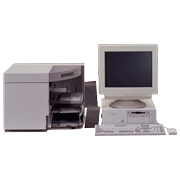In July 1994 Hitachi developed a multifunctional OCR reader, based on the Workstation OCR HT-4197 and HT-4195 readers, that was a proactive leap into the multifunctional market. As computer usage in office operations advanced further, there were demands for deeper integration between OCR readers and computers. In particular, users wanted integration with the wealth of business applications available on Windows.
The 6000 series of OCR readers addressed these integration needs. They featured multi-sensor mechanisms to cleanly scan form images, as well as reading text on slips and forms, and made it possible to automatically save image scans in sync with document-processing systems (optical disks). Furthermore, it was possible to use spreadsheet programs on computers to create forms for questionnaires or exam answer sheets, define the read parameters, and tabulate, edit, and process the scanned results.
| Processing speeds | Document mode: up to about 290 sheets per minute (6070 and 6050 models) Page mode: up to about 42 sheets per minute (6070 model) |
|---|---|
| Release date | July 1994 |
In February 1996, Hitachi implemented character recognition functions completely in software and also supplied compact dedicated OCR scanners with performance levels better than the previous model (HT-4172). Prices were lowered to under 1 million yen.
And in June 1996, Hitachi announced the Workstation OCR HT-4198, the successor to the HT-4197 and HT-4195, with even faster read speeds (about 60 sheets per minute when reading 300 handwritten numbers per A4 form), as well as the HT-4196 and HT-4194, which were about 30 percent cheaper than the previous models.


